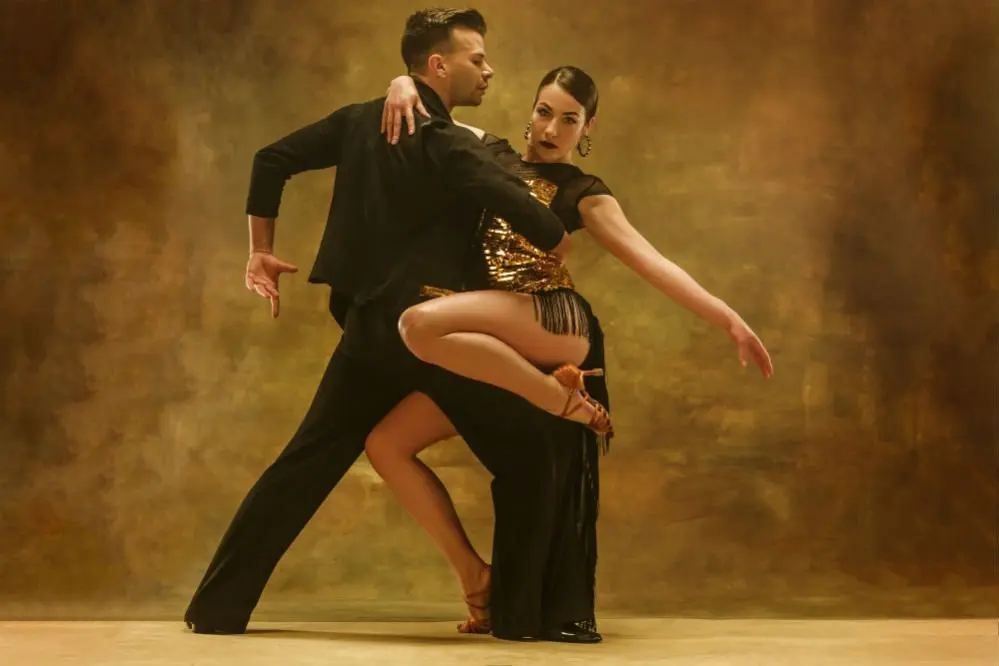55 Ballroom Dance Terminologies and Definitions for Beginners

Do you ever feel overwhelmed when you attend your ballroom dance class? There are so many new terms and steps to learn that it’s easy to feel lost.
In this post, we’ll define some of the most common ballroom dance terminologies, so you can feel confident participating in class.
Common Ballroom Dance Terms and Definitions
Here are some of the most common ballroom dance terminologies:
1. Amalgamation
Mixing two or more patterns and movements.
2. Arm Styling
The movement or position of your arms defines style and character.
3. Axel
Jumping while landing on the same foot.
4. Ball Change
The act of transferring your weight from one foot to another.
5. Break
Refers to as simple as the music is stopped.
6. Body Rise
Bracing your leg’s muscles with relaxation afterward.
7. Bow–bending
Slightly toward the waist signifies respect and acknowledgment.
8. Center
The balance point of your body.
9. Closed position
10. Change Step
Three progressing steps are usually done with the basics of the box step.
11. Promenade position.
12. Chase
The act of running after your partner.
13. Close
An act as simple as putting your feet back together.
14. Cuban Motion
Shaking the hips while alternately bending and straightening the knees.
15. Shadow position
16. Cucarachas
Side breaks.
17. Dancer’s Compass
Dancers do need to follow some movement flows. This is actually the actual diagram where they study things out.
18. Dancing Position
Standing directly in front of your partner, only being a few inches apart.
19. Outside partner position
20. Fan
One foot freely makes a circular motion.
21. Feet Apart
Just opposite the Close position, separating both legs and feet.
22. Figure
A regulated pattern of the dance movement.
23. Open position
24. Flex
This is probably the best word on the list, which means relaxing a part of your body.
25. Floor Craft
A leader’s showmanship is that he can control the dance floor, and everyone gets to follow his or her instructions.
26. Flick
An act where the pointed toe and the flexed knee give a sharp kick backward.
27. Foot Rise
Using your ankle to elevate the body.
28. Frame
Body posture or the way you carry yourself.
29. Free Spin or Free Turn
Free-spirited independent turn.
30. Freeze
To stop any movements.
31. Holds
Partners do hold hands.
32. Inside Turn
The follower turns under the left or right arm of the leader.
33. Isolation
Everything on your body is frozen except for one part, per instructions.
34. Line of Dance
The counterclockwise flow of movements dominates the dance floor.
35. Link Step
Steps that combine two or more figures.
36. Lilt
Soft and down movement of feet.
37. Lunge
Transferring the weight of the bent leg to the other extended leg.
38. Natural Opposite
Copying your partner’s exact movement, except that you are doing it in the opposite direction.
39. Natural Turn
Smooth right turn.
40. Open Break
Both partners do break continuously.
41. Open-Facing Position
Both partners stand distantly from each other while maintaining eye contact.
42. Promenade Position
Imagine you and your partner standing on each of the ends of the letter V. This term instructs them to meet at the V’s center point.
43. Reverse turn
A left turn.
44. Rise and Fall
From the words themselves, this means immediately reaching for your toes after the jumping.
45. Rock
Forward-backward-forward movement of the body while having the feet apart.
46. Shine
Partners dance without physically connecting with each other.
47. Slide
Sliding the free foot towards the weighted one.
48. Slow
Taking more beats from the music.
49. Spotting
This is a spin technique. This technique allows you to focus on one spot until you can no longer do so. This would help with the dizziness.
50. Sway
Body’s movement toward left or right.
51. Syncopate
Injecting personal touch or creativity by adding or subtracting steps from the planned choreography.
52. Tap
Tap the floor lightly.
53. Tempo
The speed of the music.
54. Variation
Mutated steps derived from the common ballroom steps.
55. Wave
A series of links far from your partner.
Resources
It may look like the longest list you would probably have to remember, but that is just the beginning.
No world-class ballroom dancer would ever have reached where he/she is now if he had never focused on studying the basic ballroom terminologies during his early career.
There would be times when you mix up these terminologies in your head.
Indeed, it can be overwhelming but do not be frustrated.
You wouldn’t be the first person ever to feel the greater benefits ballroom brings because you chose to study ballroom dance terminologies.
As you continue, you’ll see your endurance, flexibility, creativity, and social connectivity flourish.
You’ll be surprised that your health is in good shape too.
People who are fascinated by ballroom dancing could see the dance floor as their playground or school.
They see it as their playground because they can do what makes them happy.
On the other hand, some view it as their school in that they can learn greater things and discipline as they continue their practice.
However, those just starting their journey may find it quite confusing, especially since there are several dance terminologies that only those acquainted with this practice understand.
Finally, you’ll also notice that your discipline and concentration are higher than they used to be.
Frequently Ask Questions (FAQ)
What are the common dance terminologies in ballroom dancing?
In ballroom dancing, there are several common dance terminologies used to describe specific steps, movements, and techniques. Some of the common terminologies include:
1. Box Step: A basic step pattern often used in dances like the Foxtrot and Waltz, forming a square shape on the dance floor.
2. Promenade: A position where the partners dance side by side, often with one partner facing forward and the other backward.
3. Chasse: A sliding step movement used in various dances to create a gliding effect.
4. Underarm Turn: A rotational movement where the follower turns under the leader’s arm.
5. Lock Step: A step where one foot crosses in front or behind the other.
6. Closed Hold: A basic dance position where partners maintain close body contact.
These are just a few examples of the many dance terminologies used in ballroom dancing to communicate specific movements and concepts during dance instruction and performance.
What are the terms in dancing?
In dancing, various terms are used to describe specific movements, positions, and techniques. Some common terms include:
1. Alignment: The correct body positioning in relation to the dance floor and partner.
2. Balance: The ability to maintain an upright position and distribute weight evenly during movement.
3. Choreography: A sequence of dance steps and movements arranged to create a dance routine.
4. Extension: Stretching a limb to its full length to create lines and elegance in movement.
5. Spotting: A technique used in turns, where dancers focus their gaze on a fixed point to maintain balance and control.
These terms and many others are essential in dance instruction and communication to ensure precise execution and understanding of dance movements.
What are the six styles of ballroom dance?
The six main ballroom dance styles are divided into two categories: Standard Ballroom and Latin Ballroom.
Standard Ballroom:
1. Waltz: An elegant and smooth dance with graceful gliding movements.
2. Foxtrot: A sophisticated dance with long flowing steps and smooth transitions.
3. Tango: An intense, passionate dance with sharp staccato movements and strong partner connection.
Latin Ballroom:
4. Cha-Cha: A lively and flirtatious dance with quick footwork and playful hip actions.
5. Rumba: A sensual and expressive dance focusing on body movements and partner connection.
6. Swing (East Coast or West Coast): A fun and energetic dance with various styles featuring lively kicks and spins.
These styles offer a rich diversity of music and movements, making ballroom dance an enjoyable and engaging art form.
Pedia, Wiki. “Glossary of Partner Dance Terms – Wikipedia.” Glossary of Partner Dance Terms – Wikipedia, 4 May 2020, en.wikipedia.org/wiki/Glossary_of_partner_dance_terms.













Really enjoyed your article on ballroom dancing. Have done some but not for some time. A few years back when I spent some time on a couple of different occasions in the Philippines I became aware of how much they enjoy ballroom dancing in their country.
I had a lot of fun learning a bit of ballroom dancing and being around people who were really proficient dancers.
Thanks for the extensive list of terms. Didn’t realize there were so many.
You may have just inspired me to get back to the ballroom. In fact, my fiancee has been expressing interest so the timing is great. Thanks so much.
Mr. Joseph, I’m happy you enjoyed the read… Hope you and your girlfriend have lots of fun on the dance floor!… Thanks for sharing your story :)
Hi Abraham, Really enjoyed this article. There is truly something fascinating about ballroom dancing. I’m afraid as I was growing up it wasn’t ‘cool’ at all so I steered clear. My loss. I had no idea of all the terminologies that existed and I got dizzy just reading them hehe. Maybe it’s not too late for me and it’s an excellent way of meeting people in a happy healthy environment.
Dance on bro Paul
Hi Jonathan! Ballroom dancing is indeed a great way of expressing one’s self and I love it so much. I had wanted to enroll in it but I found myself procrastinating. Your article has really re-kindle the zeal to get enroll in a dancing class. Thanks for taking your time to list the terminologies so that those starting out can be conversant with these terms. It will go a long way in making the ballroom dance interesting and less confusing. Thanks for your informative article.
Ballroom dancing has seem to be one of the things I wish to do but I can’t, it’s has a lot of terminology and it’s won’t really be easy knowing them all but it is worth the try, anyone who want to go to the ballroom must understand these terms. I myself love going to the ball so I’ve got serious practice with these terminologies.
Hi Abraham,
What an awesome post! This is so chock full of useful information and dance steps that I can’t wait to dig deep and start utilizing the resources you have given me. Am a beginner so that counts a lot
I must admit I find it insightful to read your blogging. Keep up the good work.
Thanks for stopping by Ayodeji!… I’m glad you got value :D
What good information you bring to us here. I always want to do ballroom. When I watching dance with stars, I can even blink with so much beauty and elegance. The lady seems that she is flowing holded by the arms of her partner. I just need to convince my husband now, and I don’t know how, but don’t worry, I will figure out.
About the terminology that’s you talking about I definitely will have to learn every single one of the ones you present here.
Like the word ” FLOOR CRAFT” for example, before you mention I had no clue of the signification of. As you said “There would be times when you mix up these terminologies in your head”, I could tell you that I am mixed up right now, but I am sure you practice I could learning with no time, especially if will be others using this terminology around me,
Thank you for an amazing article you post.
Cheers,
Telma
Hey Telma! Thank you so much for swinging by :) I glad that we are able to provide value to you about the ballroom dance world!
Cheers